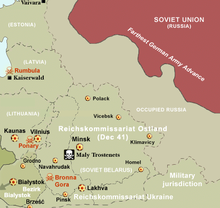玛丽·特罗斯特内兹灭绝营
玛丽·特罗斯特内兹灭绝营(德語:Vernichtungslager Maly Trostinez)[1][2],是纳粹德国在奧斯蘭總督轄區白俄罗斯明斯克郊外特罗斯特内兹(白俄羅斯語:Трасцянец)建立的灭绝营。运营于1942年7月到1943年10月间,明斯克最后的一批犹太人被杀害并埋葬于此地。[1][2]1944年7月3日,该灭绝营被苏联红军解放。
| 玛丽·特罗斯特内兹灭绝营 | |
|---|---|
| 灭绝营 | |
 玛丽·特罗斯特内兹受害者纪念碑 | |
| 知名于 | 猶太人大屠殺 |
| 位置 | 白俄罗斯明斯克 |
| 原用途 | 种族灭绝 |
| 运行时间 | 1942年–1943年 |
| 死亡 | 约 65,000 |
| 解放 | 苏军 |

参考资料
编辑- ^ 1.0 1.1 Dr. Leonid Smilovitsky. Ilya Ehrenburg on the Holocaust in Belarus: Unknown Testimony. Vol. 29, No. 1–2. East European Jewish Affairs: 61–74. Summer–Winter 1999 [1 September 2013]. (原始内容存档于2002-12-14).
Ilya Ehrenburg's Black Book cites the official data that in all, 206,500 people were murdered at Trostenets, of whom 150,000 were killed at the Blagovshchina Forest between September 1941 and October 1943, and another 50,000 at the Shashkovka Forest between October 1943 and June 1944.
- ^ 2.0 2.1 Yad Vashem. Maly Trostinets (PDF file, direct download 19.5 KB). Shoah Resource Center, The International School for Holocaust Studies. 2013 [1 September 2013]. (原始内容存档 (PDF)于2013-09-21).
参考文献
编辑- Ernst Klee and Willi Dressen, with Volker Riess, “Gott mit uns”: Der deutsche Vernichtungskrieg im Osten, 1939–1945 (Frankfurt am Main, S. Fischer, 1989).
- Shmuel Spector, ‘Aktion 1005 – Effacing the Murder of Millions’, Holocaust Genocide Studies (Oxford), vol. 5 (1990), pp. 157–173 [on the Nazi attempts to obliterate the evidence of mass murder at Maly-Trostinets (the spelling of the place-name adopted by Spector)]
- Paul Kohl, Der Krieg der deutschen Wehrmacht und der Polizei, 1941–1944: sowjetische Überlebende berichten, with an essay by Wolfram Wette (Frankfurt am Main, Fischer-Taschenbuch-Verlag, 1995) [includes a photo of the camp].
- Christian Gerlach, Kalkulierte Morde: Die deutsche Wirtschafts- und Vernichtungspolitik in Weißrußland 1941 bis 1944 (Hamburg, Hamburger Edition, 1999).
- Hans Safrian, ‘Expediting Expropriation and Expulsion: The Impact of the “Vienna Model” on Anti-Jewish Policies in Nazi Germany, 1938’, Holocaust Genocide Studies (Oxford), vol. 14 (2000), pp. 390–414 [mentions deportations from Austria to Maly Trostinets (the spelling adopted by Safrian)].
- [Ė.G. Ioffe, G.D. Knat’ko, V.D. Selemenev, comps.], Kholokost v Belarusi, 1941–1944: dokumenty i materially [Holocaust in Belarus, 1941–1944: Documents and Materials] (Minsk, NARB [National Archives of the Republic of Belarus], 2002).
- [V.I. Adamushko, et al., comps.], Лагерь смерти “Тростенец”: Документы и материалы [The Trostenets Death Camp: Documents and Materials] (Minsk, NARB [National Archives of the Republic of Belarus], 2003) [includes some 25 pages of photographic evidence; ISBN 985-6372-30-5].
- [K.I. Kozak, et al., eds.], Henatsyd u druhoĭ susvetnaĭ vaĭne: Prablemy dasledavanniya u pamiyats akhviyar Trastsiyantsa... (Minsk, Vydavetski tsentr BDU, 2003) [proceedings of the international conference on the subject of the ‘Todeslager Trostenez’ (so spelt in the book) held in Minsk between April 25 and 27, 2002].
- S.V. Zhumar’ & R.A. Chernoglazova, comps., Trostenets (Minsk, GK ‘Poligrafoformlenie’, 2003) [published under the auspices of the Belarus government; includes summaries in English and German; Library of Congress call No. D805.5.M358 T76 2003].
- Igor’ Kuznyetsov, ‘В поисках правды, или Трагедия Тростенца: до и после’ [In Search of Truth; or, The Tragedy of Trostenets: Before and After], Belorusskaya delovaya gazeta [Belarus Business News] (Minsk), No. 1416 (April 2, 2004) [makes the interesting claim, supported in part by references to published sources (e.g., A.I. Zalesskiĭ, I.V. Stalin i kovarstvo ego politicheskikh protivnikov, 2 vols., Minsk, 1999–2002), that the Blagovshchina Forest had previously been the execution ground of choice for the local branches of the Soviet NKVD].
- [Petr Krymsky], ‘Тростенец – белорусский “Oсвенцим”’ [Trostenets – Belarusian ‘Auschwitz’], Rossiĭskie vesti [Russian News] (Moscow), No. 16 (1771), May 11–18, 2005 [seems to take issue with the claims made in the preceding article; includes two contemporary photographs of Soviet excavations].
- [Z.R. Iofe, et al., eds.], Laher smertsi Tras’tsyanyets, 1941–1944 hh.: pamiyatsi akhviyar natsyzma ŭ Belarusi [The Tras’tsyanyets Death Camp, 1941–1944: In Memory of the Victims of Nazism in Belarus] (Minsk, Histarychnaiya maĭstėrniya, 2005).
- The Invasion of the Soviet Union and the Beginnings of Mass Murder on the Yad Vashem website
- Marking 70 Years to Operation Barbarossa on the Yad Vashem website